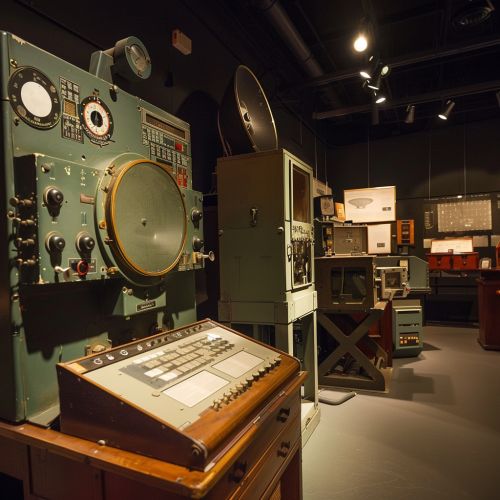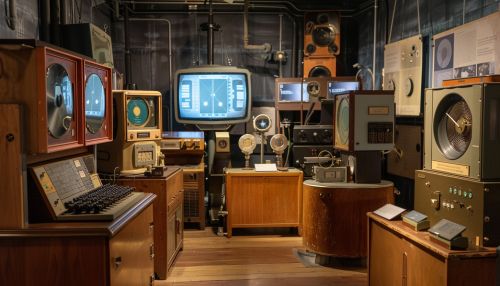History of radar: Difference between revisions
(Created page with "== Early Development of Radar == Radar, an acronym for Radio Detection and Ranging, is a system that uses radio waves to detect and locate objects. The history of radar is deeply intertwined with the development of radio technology and the needs of military and civilian applications. === Pre-World War II === The concept of using radio waves to detect objects dates back to the late 19th century. In 1886, Heinrich Hertz demonstrated that radio waves could be reflect...") |
No edit summary |
||
| Line 17: | Line 17: | ||
Germany also made significant advancements in radar technology during the war. The [[Würzburg radar]] was used for air defense, while the [[Freya radar]] was employed for early warning and aircraft tracking. Japan and the Soviet Union also developed their radar systems, although they were not as advanced as those of the Allies and Germany. | Germany also made significant advancements in radar technology during the war. The [[Würzburg radar]] was used for air defense, while the [[Freya radar]] was employed for early warning and aircraft tracking. Japan and the Soviet Union also developed their radar systems, although they were not as advanced as those of the Allies and Germany. | ||
[[Image:Detail-95953.jpg|thumb|center|Historical radar equipment in a museum setting.|class=only_on_mobile]] | |||
[[Image:Detail-95954.jpg|thumb|center|Historical radar equipment in a museum setting.|class=only_on_desktop]] | |||
== Post-War Developments == | == Post-War Developments == | ||
Latest revision as of 21:31, 3 July 2024
Early Development of Radar
Radar, an acronym for Radio Detection and Ranging, is a system that uses radio waves to detect and locate objects. The history of radar is deeply intertwined with the development of radio technology and the needs of military and civilian applications.
Pre-World War II
The concept of using radio waves to detect objects dates back to the late 19th century. In 1886, Heinrich Hertz demonstrated that radio waves could be reflected from solid objects. This fundamental discovery laid the groundwork for future developments in radar technology. In the early 20th century, several inventors and scientists, including Christian Hülsmeyer, experimented with radio-based detection systems. Hülsmeyer, a German engineer, patented an early form of radar in 1904, which he called the "Telemobiloscope." However, his invention was not widely adopted at the time.
During the 1920s and 1930s, advancements in radio technology, particularly in the field of radio frequency amplification and the development of the superheterodyne receiver, made radar more feasible. In 1935, Sir Robert Watson-Watt, a Scottish physicist, demonstrated the practical use of radar to detect aircraft. His work led to the development of the first operational radar systems in the United Kingdom.
World War II
World War II was a significant catalyst for the rapid advancement of radar technology. Both the Allies and the Axis powers recognized the strategic importance of radar for detecting enemy aircraft and ships. The British developed the Chain Home radar system, which became operational in 1938. This network of radar stations provided early warning of incoming German aircraft during the Battle of Britain.
In the United States, the Radiation Laboratory at the Massachusetts Institute of Technology (MIT) played a crucial role in radar research and development. The lab developed the SCR-270 radar, which detected Japanese aircraft approaching Pearl Harbor on December 7, 1941, although the warning was not acted upon in time to prevent the attack.
Germany also made significant advancements in radar technology during the war. The Würzburg radar was used for air defense, while the Freya radar was employed for early warning and aircraft tracking. Japan and the Soviet Union also developed their radar systems, although they were not as advanced as those of the Allies and Germany.


Post-War Developments
After World War II, radar technology continued to evolve rapidly. The Cold War spurred further advancements as both the United States and the Soviet Union sought to improve their radar capabilities for air defense and missile detection. The development of transistor technology in the 1950s and 1960s led to more compact and reliable radar systems.
Civilian Applications
Radar technology also found numerous civilian applications. In aviation, radar became essential for air traffic control, weather monitoring, and navigation. The development of Doppler radar allowed meteorologists to track weather patterns and predict severe weather events more accurately. In maritime navigation, radar became a critical tool for avoiding collisions and navigating in poor visibility conditions.
Advances in Technology
The latter half of the 20th century saw significant advancements in radar technology. The development of phased array radar allowed for faster and more precise tracking of multiple targets. The advent of synthetic aperture radar (SAR) enabled high-resolution imaging of the Earth's surface, which has applications in remote sensing, geology, and military reconnaissance.
The introduction of digital signal processing (DSP) revolutionized radar systems by improving their accuracy and reliability. Modern radar systems can process vast amounts of data in real-time, allowing for more sophisticated tracking and detection capabilities.
Modern Radar Systems
Today, radar technology is used in a wide range of applications, from automotive radar for collision avoidance to space-based radar for monitoring the Earth's environment. The development of stealth technology has also driven advancements in radar, as engineers work to design systems capable of detecting stealthy aircraft and missiles.
Military Applications
In the military domain, radar remains a critical component of air defense, missile detection, and battlefield surveillance. Modern radar systems, such as the AN/SPY-1 used in the Aegis Combat System, are capable of tracking hundreds of targets simultaneously and guiding interceptor missiles to their targets.
Civilian Applications
In addition to its military uses, radar technology continues to play a vital role in civilian applications. Air traffic control relies on radar to ensure the safe and efficient movement of aircraft. Weather radar systems provide crucial data for forecasting and monitoring severe weather events. Automotive radar systems are increasingly being integrated into vehicles to enhance safety through features such as adaptive cruise control and collision avoidance.
Future Trends in Radar Technology
The future of radar technology is likely to be shaped by several key trends. The development of quantum radar holds the promise of detecting objects with unprecedented accuracy and sensitivity. Advances in machine learning and artificial intelligence are expected to enhance radar systems' ability to process and interpret data, leading to more autonomous and intelligent systems.
The integration of radar with other sensing technologies, such as lidar and infrared imaging, is likely to create more comprehensive and versatile detection systems. Additionally, the miniaturization of radar components will enable the development of more compact and portable radar systems for a variety of applications.
See Also
- Radio Frequency
- Superheterodyne Receiver
- Doppler Radar
- Phased Array Radar
- Synthetic Aperture Radar
- Digital Signal Processing
- Stealth Technology
- Quantum Radar
- Machine Learning
- Artificial Intelligence
- Lidar
- Infrared Imaging
